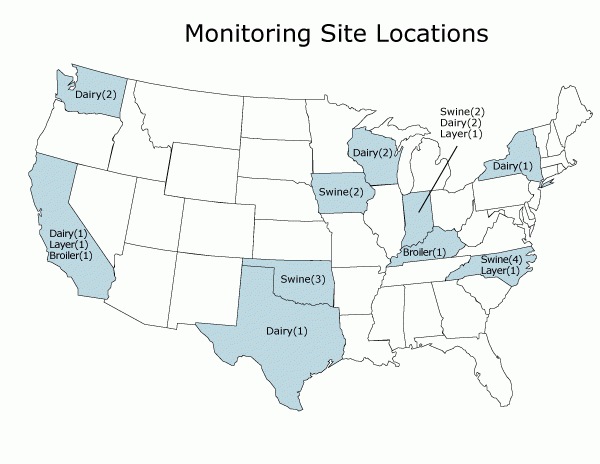National Air Emissions Monitoring Study
- The National Air Emissions Monitoring Study (NAEMS)
- NAEMS Status
- Draft Emission Models
- NAEMS Data
- 2005 Voluntary AFO Air Compliance Agreement
The National Air Emissions Monitoring Study (NAEMS)
- A 2002 report by the National Academy of Sciences called on EPA to develop scientifically credible methodologies for estimating emissions (emission models) from animal feeding operations (AFOs). Emission models are commonly used to estimate emissions from industries where site-specific monitoring data are not available.
- NAEMS monitored barns and lagoons at 25 AFOs in 10 states over two years to measure emissions of ammonia, hydrogen sulfide, particulate matter, and volatile organic compounds. The study gathered this data in order to develop emission models, as recommended by the National Academy of Sciences.
- The study was funded by the AFO industry as part of a 2005 voluntary air compliance agreement with EPA. University researchers conducted this monitoring with EPA oversight.
- The types of AFOs monitored included those raising pigs, broiler chickens, egg-laying operations, and dairies. Participating AFOs made their operations available for monitoring for two years and worked closely with the researchers, industry experts, and EPA during the study.
- In addition to monitoring key pollutants, university researchers gathered data on how animals were managed at the feeding operations, including numbers of animals, how they were housed, and how their waste was managed. They also gathered data on weather.
NAEMS Status
EPA is currently developing draft emission models using the data gathered during NAEMS and a 2011 Call for Information for AFOs.
|
||||||||||||||||||||||||
|---|---|---|---|---|---|---|---|---|---|---|---|---|---|---|---|---|---|---|---|---|---|---|---|---|
Draft Emission Models
- In 2012, EPA used information gathered in NAEMS, along with information provided as part of the 2011 Call for Information, to develop draft emission models for some of the AFO sectors that were monitored.
- The EPA Science Advisory Board (SAB) conducted a peer review of these original draft emission models and made suggestions for improving the models. Materials related to this peer review, including charge questions, meeting minutes and the SAB report are available from the Animal Feeding Operations Air Emission Estimation Methodologies SAB panel.
- EPA is applying the SAB suggestions and developing draft emission models for each AFO sector.
- The models estimate farm-scale emissions using information that producers already record or is easy to get (like weather data).
- The models are not "process-based." There are many different site-specific processes that affect a farm's emissions. These models do not include all these processes, so the results of the models are estimates.
- For questions, suggestions, and voluntary submissions of supplemental data or information, email the NAEMS Group (NAEMS@epa.gov).
NAEMS Data
The final reports for data gathered at each site monitored during NAEMS are available in EPA's archive. (search term: "2012 monitored AFOs") Search EPA Archive
2005 Voluntary AFO Air Compliance Agreement
- EPA announced the voluntary Air Compliance Agreement in 2005, with goals of reducing air pollution, monitoring AFO emissions, promoting a national consensus on emissions estimating methodologies, and ensuring compliance with requirements of the Clean Air Act and notification provisions of the Comprehensive Environmental Response, Compensation, and Liability Act (CERCLA), and the Emergency Planning and Community Right-to-Know Act (EPCRA).
- EPA worked with industry representatives, state and local governments, environmental groups and other stakeholders to develop the voluntary agreement. Approximately 2,600 AFOs, representing nearly 14,000 facilities, received EPA approval to participate.
- Participating AFOs paid a civil penalty of between $200 and $100,000, based on the size and number of facilities in their operation. They also contributed to a fund to cover the cost of the monitoring study.
- As part of the agreement, EPA agreed not to sue participating AFOs for certain past violations of the Clean Air Act, CERCLA and EPCRA, provided that the AFOs comply with the agreement’s conditions. However, the agreement does not limit EPA’s ability to take action in the event of imminent and substantial danger to public health or the environment. It also preserves state and local authorities’ ability to enforce local odor or nuisance laws.
- Due to legislation and subsequent rulemaking, reporting of air emissions from animal waste at farms is not required under CERCLA or EPCRA.
- Once EPA publishes final emissions estimating methodologies for an AFO’s animal sector, that AFO must apply the final methodologies to determine what actions, if any, it must take to comply with all applicable Clean Air Act requirements.

